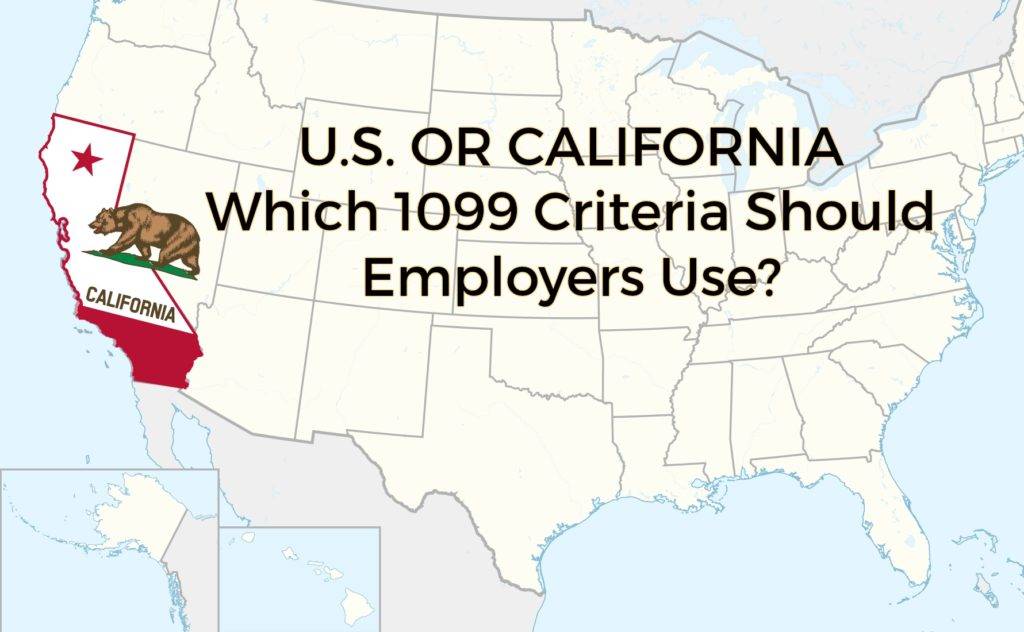- California’s “ABC Test” and the U.S. Federal Agencies’ “Common Law Rules” have presented employers with conflicting standards on how to engage with workers as independent contractors.
- To prevent worker misclassification penalties, businesses should supplement their work force by leveraging staffing firms to hire workers as W-2 employees.
In 2019, the State of California and federal agencies have presented conflicting standards on what constitutes a worker as an independent contractor.
A California Bill proposed in December 2018 is attempting to cement the “ABC Test” as the standard to identify independent contractors, or more commonly referred to as 1099 contractors (named after the tax form they receive at the end of the year).
The California Supreme Court first implemented this standard in 2018 in the historic case of Dynamex Operations West VS Los Angeles Superior Court.
The ABC Test consists of the following 3-Prong Criteria:
- PRONG A: The worker is free from the control and the direction of the hiring entity in connection with the performance of the work
- PRONG B: The worker performs work that is outside the usual course of the hiring entity’s business
- PRONG C: The worker is customarily engaged in an independently established trade, occupation, or business
Proponents of the ABC Test said that this new standard keeps businesses from misclassifying workers as 1099s to avoid paying for benefits and employer taxes for these workers.
Opponents of this standard said that the more stringent nature of Prong B prevents companies from working with outside workers, vendors and sub-contractors as 1099s since it would be hard to prove that the work being performed is outside the business’ usual course. The primary opponents of this standard are the tech companies working in the “gig economy” such as Uber, Lyft, Door Dash, etc.
Meanwhile, in a recent advisory memo written by the National Labor Relations Board (NLRB) General Counsel, Peter Robb, stated that gig economy workers such as Uber drivers are identified as independent contractors, based on the multi-point standards of the “Common Law Rules”.
With the Common Law Rules, factors that are taken into consideration include: control of the worker’s time, how labor is performed, equipment ownership, compensation arrangements and if the hiring entity intends to provide the worker with benefits. Businesses feel that the Common Law Rules give them more flexibility to engage with 1099 contractors.
The NLRB argues that using this criteria, those who are in the gig economy have freedom to choose their own work schedules, and are not limited to working with only one company – which makes them independent contractors and not employees.
Why does this matter to engineers?
There are many tech companies within the Silicon Valley and southern regions of California who regularly engage with mechanical, electrical and manufacturing engineers as 1099 contractors for short-term projects, subject matter consultation or for brief upswing in workload. By bringing in these workers as 1099, it allows businesses the flexibility of increasing and decreasing their workforce rapidly without the usual on-boarding requirements and overhead of hiring regular W2 employees.
With all these conflicting standards on what a 1099 is, there’s a higher risk of misclassifying a worker which could potentially lead to expensive fines and penalties.
To avoid misclassification, consider engaging workers as W-2 contractors by leasing them through an experienced staffing firm. Leasing contract workers allow companies the same flexibility as working with 1099 contractors and the ability to “outsource” the responsibilities and risks of being an employer to the staffing firm. Staffing firms are typically equipped to handle both state and federal employer’s compliance requirements (employers’ taxes, ACA, worker’s comp…etc.) The employer/employee landscape is not an easy one to navigate and it is increasingly likely to run afoul of new regulations. Business can mitigate their risks by considering an employee leasing model and focus on their core competency.
By leasing contract workers through staffing firms, companies can transfer the employment burden and stay in compliance with state and federal laws. To find out how employee leasing works, contact SoloPoint Solutions today!
[contact-form to=”saraa@solopointsolutions.com” subject=”Response to 1099 Article”][contact-field label=”Name” type=”name” required=”1″][contact-field label=”Email” type=”email” required=”1″][contact-field label=”Company” type=”text”][contact-field label=”Message” type=”textarea”][/contact-form]

